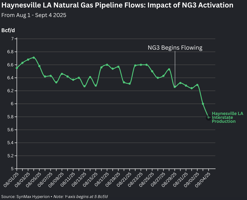2/5/25
NatGas Long Term Forecast & Daily Production Model Update
SynMax has updated our Long Term NatGas production forecast and Daily Production Model. All changes are now live on the Energy Dashboard, API, Excel Addin and in Snowflake.
Long Term Nat Gas Forecast Changes
As shown in the chart above we have, on average, revised our natgas production expectations higher. March 2025 through December 2025 is revised up by 0.6 Bcf/d from the prior quarter and we expect producers to increase their rig and frac crew activity by Q2’25 as a consequence of higher Henry Hub prices. We also do not expect producers to curtail production in 2025 as they did in 2024.
For a detailed discussion about these changes including insights from producer earnings and risks to our model please consider attending our Quarterly Production Webinar tomorrow Thursday 3/20 at 9am CST.
Daily Production Model Changes
We are revising our Daily Production Model +0.92 bcfd for the current production month. The average revision over the prior 12 months is +0.504 bcfd as seen in the chart above.
The largest revision comes from Southwestern Pennsylvania (SW PA) where we have revised volumes 0.87 bcfd higher. Since the MVP pipeline began operations in Jun’24 we have seen a growing divergence between SW PA pipeline scrapes and state reported production. The difference was subtle at first but became extreme in Nov’24 and Dec’24 where state production volumes grew significantly at the same time that interstate pipeline scrapes fell. This is due to interstate gathering systems like Hammerhead which can bring production across state lines silently. When the FERC classifies a pipeline as a gathering system it is immune from reporting requirements making these interstate flows opaque.
There is an offsetting effect between regions as gathering systems collecting gas in one region sometimes still show flows in another. We estimate the offsetting impact to West Virginia (WV) to be -0.33 bcfd. So the net impact of this offset still produces a net increase in production between the two regions SW PA and WV of 0.54 bcfd.
Now that we have identified this effect with some amount of supporting state data we have recalibrated our SW PA and WV models to compensate. There are two main risks to our model going forward. 1. We do not yet have enough state history to understand the potential seasonal impacts of this change. For example, the ratio of SW PA to WV production on Hammerhead and other interstate gathering systems may change between winter and summer. 2. We do not have enough WV state reported data to verify the offsetting exactly. States like PA tend to report volumes timely with as little as a three month lag but states like WV can sometimes take up to a year to make volumes public.
We will continue to watch this situation closely and update customers with any new insights or revisions.

